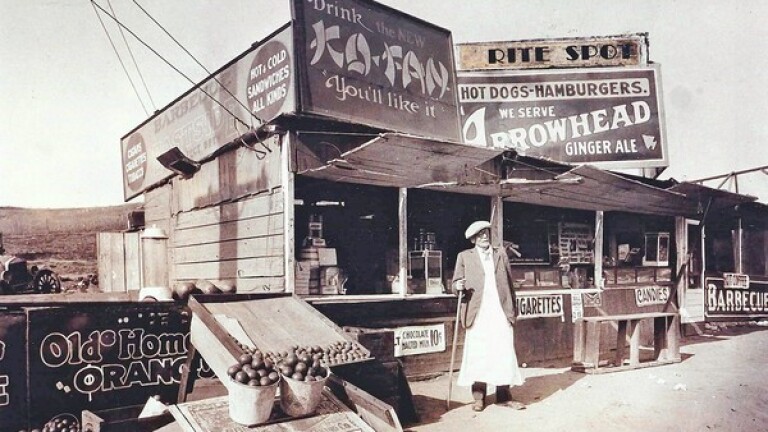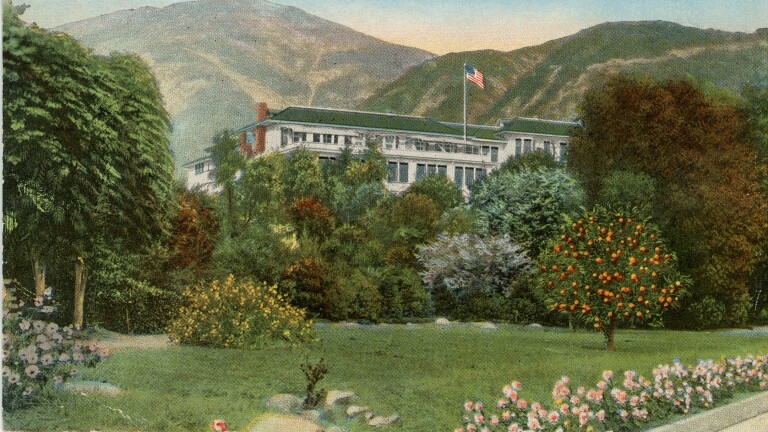El Aliso: Ancient Sycamore Was Silent Witness to Four Centuries of L.A. History

Although non-native trees have come to define Los Angeles visually, one of the city's indigenous trees once occupied the same symbolic space now captured by the palm: an ancient sycamore known in its later years as El Aliso. A witness to four centuries of Southern California history, the tree dominated the landscape of early Los Angeles, measuring 60 feet tall, its canopy spreading nearly 200 feet from tip to tip.
El Aliso sprang from the ground near the western bank of the Los Angeles River in the late fifteenth century -- in an ominous coincidence, about the same time Columbus arrived in the Americas. As it matured, the sycamore -- located at the juncture of the Los Angeles coastal plain and the San Fernando and San Gabriel valleys -- became a gathering place for Los Angeles' indigenous Tongva people. Local leaders traveled from their villages across Southern California to confer under the shade of the tree's canopy.
The sprawling sycamore gained almost totemic significance. In a landscape virtually free of permanent structures, the towering tree would have been visible for a great distance, and in the summer heat it would have provided welcome relief from the sun. The Tongva reportedly reckoned distances in relation to the tree, and traders from as far away as present-day Yuma knew the tree as a landmark. By the mid-eighteenth century, the mighty sycamore stood at the center of one of the largest Tongva villages, Yaanga.
The tree continued to grow in height and breadth as Spain colonized the region and radically transformed life in the village under the sycamore's boughs. Impervious to the political and cultural whirlwind surrounding it, the tree acquired a new, Castilian name: El Aliso. ("Aliso" typically refers to an alder tree, but in Alta California it was often mistakenly applied to sycamores, as well.) In 1781, Spain founded a new agricultural settlement within a stone's throw of El Aliso: El Pueblo de la Reina de Los Angeles.
Early Angelenos depended on the inhabitants of Yaanga for manual labor and for hand-made goods. But Spanish colonization soon devastated the Tongva village. Many residents were drawn to the nearby Mission San Gabriel Arcangel, where missionaries imposed Spanish culture upon those who converted. Those who remained in Yaanga lived under the increasingly dominant sway of the pueblo, which slowly encroached on the village. By the 1830s, El Aliso had ceased to function as the symbolic center of daily Tongva life as Yaanga changed locations twice before dissolving into historical oblivion.


El Aliso, meanwhile, survived one of the worst recorded floods in Los Angeles: the 1825 deluge that changed the course of the Los Angeles River, diverting the watercourse from the present-day Ballona Creek watershed to San Pedro Bay. According to landscape architect John Crandell, who has researched the history of the tree and the surrounding landscape, El Aliso was once part of an extensive riparian forest that, before the 1825 flood, thrived alongside the Los Angeles River and the region's inland wetlands. Most of El Aliso's companion trees fell as a result of the flooding, which buried their trunks under several feet of sediment. But with its stout build, El Aliso withstood the flood.
In 1837, French immigrant Jean-Louis Vignes opened a winery on the land surrounding El Aliso, building his cellar in the tree's shade and naming his winemaking operations in the ancient sycamore's honor. At its peak, El Aliso Vineyard was producing nearly 150,000 bottles of French-style wines each year. In 1855, Vignes' nephews Pierre and Jean Louis Sainsevain purchased the winery and two years later produced the first California sparkling wine, which they shipped north to San Francisco. El Aliso had become the center of a burgeoning Frenchtown, known for fine French dining and viticulture.
By the 1870s, the cultural landscape around El Aliso had again shifted. In 1875, German immigrants purchased the old El Aliso winery and converted it into one of Los Angeles' first breweries, the Philadelphia Brewery. El Aliso continued to anchor the brewery's courtyard, its branches shading Vignes' former cellar and now protecting German lager rather than French wine from the Southern California sun.
While useful at first, the ancient sycamore soon became an obstacle to industrial-scale success. Joseph Maier and George Zobelein purchased the brewery in 1882 and began to aggressively expand production. In 1889, they replaced the brewery's original one-story wooden structures with multi-story masonry buildings, in the process removing most of El Aliso's branches and enclosing the tree on three sides. Only the massive arms extending out over Aliso Street, the roadway that bore the tree's name, remained.
Though it had withstood countless brush fires and floods, the dismembered tree could not survive the stresses of urban development. Crandell suspects that several factors -- including reduced foliage, the addition of granite pavers on Aliso Street, and a loss of exposed topsoil -- spelled the tree's doom. In 1892, a large branch fell and crushed a brewery wagon valued at $400. Despite his partner's protestations, Maier promptly removed El Aliso's remaining branches. By the end of the year, the tree was dead.
El Aliso's lifeless trunk stood in the brewery courtyard until in 1895, when it was felled and sold for firewood. Longtime residents flocked to the brewery to watch as William Willoughby, whom the Los Angeles Times described as "an experienced axman," chopped away at the hefty trunk. Many collected wood chips as relics.
Today, no public monument or bronze plaque marks the site of El Aliso or the Tongva village of Yaanga. According to Crandell, the tree grew 153 feet north of Commercial Street and 88 feet east of Garey Street. That puts the tree's site underneath an onramp for the 101 freeway, directly across the highway from Union Station and within earshot of the Déjà Vu gentlemen's club. Cars whisk by, and the club's neon sign blinks at one of L.A.'s most ancient historic sites.





Many of the archives who contributed the above images are members of L.A. as Subject, an association of more than 230 libraries, museums, official archives, personal collections, and other institutions. Hosted by the USC Libraries, L.A. as Subject is dedicated to preserving and telling the sometimes-hidden stories and histories of the Los Angeles region. Our posts here provide a view into the archives of individuals and cultural institutions whose collections inform the great narrative—in all its complex facets—of Southern California.


